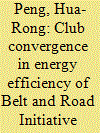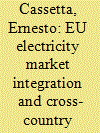|
|
|
Sort Order |
|
|
|
Items / Page
|
|
|
|
|
|
|
| Srl | Item |
| 1 |
ID:
079065


|
|
|
|
|
| Publication |
2007.
|
| Summary/Abstract |
This paper uses provincial panel data to examine club convergence in China during 1981-2004. We estimate the province-specific initial technology level, A(0), and classify the Chinese economy into "developed club" and "underdeveloped club" based on the economic characteristics of A(0), instead of on geographical location. We find significant evidence of conditional convergence across provinces, and that the convergence speed in the developed club is faster than that in the underdeveloped club. We also find that: (i) human capital accumulation contributes more than physical capital does to club convergence; (ii) there is a positive correlation between infrastructure and growth convergence at the national level and within the developed club, while the spillover effect of infrastructure has not been developed in the developing club; and (iii) the effect of economic openness on convergence is tiny, and insignificant across and within clubs
|
|
|
|
|
|
|
|
|
|
|
|
|
|
|
|
| 2 |
ID:
168503


|
|
|
|
|
| Summary/Abstract |
The objective of this study is to investigate the presence of ‘club convergence’ in respect of income among 15 major states in India during 1982–2014 using Markov chain along with stochastic kernel. The distributional dynamics observed among the major states support the process of ‘club convergence’. The empirical findings prove the hypotheses that economies that are similar in their structural characteristics and initial per capita income levels will converge with each other in per capita terms in the long run. The present study empirically re-establishes the hypotheses of ‘low-level equilibrium trap’ caused by low human capital investment.
|
|
|
|
|
|
|
|
|
|
|
|
|
|
|
|
| 3 |
ID:
186490


|
|
|
|
|
| Summary/Abstract |
Countries along with the Belt and Road Initiative (BRI) differ in geographical location, technological levels, and resource endowment. It is worth paying attention to the evolution of the gap in energy efficiency of BRI countries. Therefore, this study investigated club convergence in total-factor energy efficiency (TFEE) of BRI countries, and the role of China's outward foreign direct investment (OFDI) in TFEE convergence, by adopting panel data over 1996–2019. Results indicate that the TFEE of the BRI countries showed a trend of divergence as a whole, but converged to three convergence clubs with different characteristics of 1) high TFEE and convergence rates (20 countries); 2) middle TFEE and convergence rates (13 countries), 3) low TFEE and convergence rates (27 countries). We also found that China's OFDI in low-carbon industries in BRI countries contributed to the convergence of clubs with high energy efficiency and convergence rates. Moreover, China's OFDI in high-carbon industries showed a pollution halo effect, causing lower energy efficiency countries to converge to the high energy efficiency and convergence rate club.
|
|
|
|
|
|
|
|
|
|
|
|
|
|
|
|
| 4 |
ID:
125627


|
|
|
|
|
| Publication |
2013.
|
| Summary/Abstract |
The aim of this paper is to investigate the environmental convergence hypothesis in carbon dioxide emissions for a large group of developed and developing countries from 1980 to 2009. The novel aspect of this work is that we distinguish among carbon dioxide emissions according to the source of energy (coal, natural gas and petroleum) instead of considering the aggregate measure of per capita carbon dioxide emissions, where notable interest is given to the regional dimension due to the application of new club convergence tests. This allows us to determine the convergence behaviour of emissions in a more precise way and to detect it according to the source of energy used, thereby helping to address the environmental targets. More specifically, the convergence hypothesis is examined with a pair-wise test and another one is used to test for the existence of club convergence. Our results from using the pair-wise test indicate that carbon dioxide emissions for each type of energy diverge. However, club convergence is found for a large group of countries, although some still display divergence. These findings point to the need to apply specific environmental policies to each club detected, since specific countries converge to different clubs.
|
|
|
|
|
|
|
|
|
|
|
|
|
|
|
|
| 5 |
ID:
185691


|
|
|
|
|
| Summary/Abstract |
Despite significant efforts in market integration and regulatory harmonization, large heterogeneities in retail electricity prices across Member States still remain one of the main concerns of the European Union. Here, the cross-country convergence of households and industrial end-user electricity prices in the EU between 2008 and 2021 is investigated. Relying on the notion of club convergence, empirical findings reveal the existence of multiple clubs. The household and non-household market segments exhibit rather different paths in terms of price convergence. Domestic end-user prices show higher dispersion and heterogeneity across national electricity markets than industrial one. Differences across convergence clubs seem to be related with public intervention in the electricity end-user price setting, disparities in the range of household or industrial consumers under regulated end-user prices, and different criteria used among countries in defining energy components. Policy-wise, the club convergence analysis emphasizes the need of stronger cooperation for public intervention and regulation, while considering how end-user price setting can support the decarbonization of the EU electricity systems.
|
|
|
|
|
|
|
|
|
|
|
|
|
|
|
|
| 6 |
ID:
116531


|
|
|
|
|
| Publication |
2012.
|
| Summary/Abstract |
A new panel method is applied to the case of Chinese provinces to analyze the existence of club convergence in terms of per capita income, labor productivity, and capital intensity, from 1952 to 2008. The advantage of this approach is that it takes into account the heterogeneity of Chinese regions in a nonlinear time-varying framework, where more attention is paid to the spatial dimension. This time-varying approach outperforms other methods used in the relevant literature for an economy in transition, such as China, that has undergone a significant transformation over the period under consideration. Our results indicate that Chinese regions have converged into clubs. However, it is observed that Heilongjiang is diverging in terms of labor productivity and capital intensity, while Liaoning and Guizhou display similar patterns in terms of labor productivity, and Shanxi and Hebei in terms of capital intensity. These results indicate that specific economic packages need to be implemented in the clusters that were identified, with special attention to those regions that show a divergence behavior, in order to guarantee the sustainability and equality of regional growth.
|
|
|
|
|
|
|
|
|
|
|
|
|
|
|
|
|
|
|
|
|